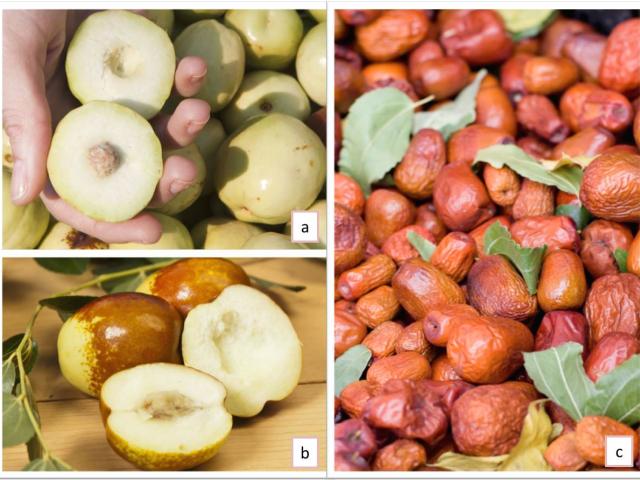 In the orchard
In the orchard
Irrigation
Irrigation is an important factor for producing a good yield of quality jujubes. Irrigation scheduling has a direct impact on tree health and fruit yield as well as size and quality. Without correct scheduling an orchard is more susceptible to nutrient deficiencies, physiological disorders, pests and diseases.
See Jujube irrigation recommendations for more information.
Nutrition
Correct nutrition of jujube trees is essential if they are to crop and perform to their maximum potential. Annual leaf analysis in January (or 10 weeks after flowering) is essential to develop a fertiliser program for your orchard. Soil analysis can also be a good insight into soil fertility and pH. Excessive or insufficient fertiliser application can cause problems that will affect fruit quality.
See Jujube fertiliser recommendations for more information.
Training and pruning
Trees should be trained to develop a strong structure and fill their allotted space as quickly as possible with canopies that facilitate for efficient management (e.g. spraying, harvesting etc.).
Jujube trees need to be pruned annually to enable the tree to bear a full crop. Thinning and removal of damaged and diseased wood also improves pest and disease control.
Pest and disease control
Diseases and insect pests need careful management to prevent poor fruit set, misshapen fruit and skin and flesh damage. Efficient management relies on regular monitoring of your orchard. Pest populations should be kept below levels that will cause financial losses but must meet legal pesticide residue regulations.
Pest monitoring should be conducted on a weekly basis and recorded. You should keep a record of all chemicals used, dates and rates of applications. Percentage losses from insect and disease damage should also be recorded at grading after harvest.
Maturity
Jujube fruit matures from February to May in Western Australia (based on currently grown cultivars). Immature fruits have green skin and will not ripen if picked. Fruit picked later will continue to ripen after harvest. The fruit can be left on the tree to be picked when dried.
Fruit maturation of Chinese jujube can be divided into three phases based on colour, flesh firmness and composition (starch, sugar, acid, water):
-
White mature: The fruit is near full size and shape; the skin of the fruit is thin and changes from green to greenish white in colour. Flesh becomes white and loose with less juice and sugar and more starch.
-
Crisp mature: The fruit skin is half to fully red in colour, becomes thicker, harder and easily separated from the flesh which becomes crisp, juicy and sweet, containing more sugar and acid.
-
Fully mature: Sugar content of the flesh increases rapidly and water content begins to decrease. The flesh near the stone and fruit stalk becomes yellow and soft. The skin changes to a dark red and fruit becomes wrinkled.
Harvesting
The proper harvesting time depends on the end use of the fruit (fresh consumption, dried or processed). For fresh consumption jujubes should be picked at the crisp mature stage to prolong storage life. Fruits to be dried should be picked when fully mature and fruits for candying should be picked at the white mature stage.
Fruit harvested for fresh consumption is usually hand-picked. Fruit that is dried can be left on the tree until it drops or harvested by shaking the tree or branches.
Harvest jujubes early in the morning when temperatures are cool. The higher the temperature of the fruit, the greater the need for refrigeration for cooling and the greater the cost.
Fruit should be as free as possible from breaks, bruises, decay and other damage which increases moisture loss and provides entry points for bacteria and fungi.
Before transport to a packing shed, ensure fruit is kept in the shade in a shed. Jujubes should be transported with a cover to the packing shed within a few hours of harvesting.
Dried jujube fruit can be obtained by drying under the sun for about 3 weeks or in a cabinet drier at 60℃ for 36-48h until the moisture content reduced to less than 25%.
Fruit quality testing
It is important to pick jujubes at the correct maturity and size for marketing. Requirements for local and overseas markets often differ.
Total soluble solids is an internal maturity parameter that should be tested. Sugar levels are a commonly used measurement in a wide range of crops.
The sample you test should be typical of what you are planning to pick. Pick at least 10 pieces of fruit (the more fruit you pick, the greater the accuracy of your results). Pick fruit from at least 10 trees across the block and from all sides of the trees. If you have more than one variety then you should test these separately.
The percentage sugar, measured in degrees Brix (°Brix), indicates the sweetness of the fruit by measuring the number of soluble solids in the juice. A hand-held refractometer can be used to measure total soluble solids (percentage sugar/°Brix).
Figure 2 shows total soluble solids of jujube fruit grown in WA. The variety Li had the highest level of total soluble solids (31°Brix) of the three varieties tested and Chico had the lowest (25°Brix).


